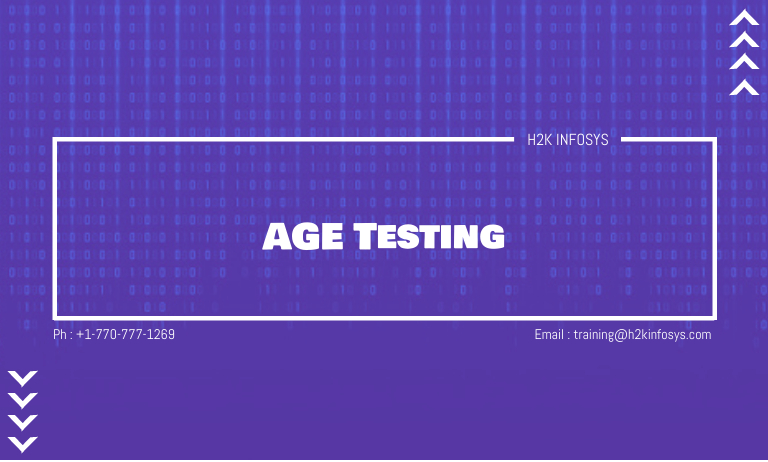Age testing is a testing technique which evaluates a system’s ability to perform in the future and also carried out by test team. It tests, as the system gets older, how significantly it might drop in performance, is what is measured in Age Testing.
There are different types in Age
- Defect Age- It is measured by two parameters
- Time
- Phases
Defect age steps will be defined as difference between defect injection phase and defect detection phase.
Parameters:
- ‘Defect injection phase’ is the phase of software development life cycle when the defect was introduced.
- ‘Defect detection phase’ is the software development life cycle whenever the defect is pinpointed.
The main formula is:
Defect Age in Phase = Defect detection phase – Defect injection Phase.
Defect Age –Time is defined as the time difference between defect detected date and also the current date,which is provided the defect will still be open.
Parameters
- Defects are in “open” and” Assigned” status and just in “New” status.
- Defects are “closed” due to “non-reproducible” or “duplicate” are not considered.
- Difference in days or may be hours is calculated from the defect open date and current date.
The formula is
Defect Age in Time = Defect Fix date or current Date – Defect Detection Date
Age testing is mainly done to check the performance of the system when it gets older. This testing is performed by the software testers. When there is any application or software product is being developed. Software testers perform a different type of testing in it to make sure that the developed application is working as expected and giving the desired results. Age testing is also part of the system or may be application which is working fine, as now, all the bugs which have been fixed. How it behaves in future? Here age testing is evaluated by the defect age.
For example:
Let’s consider if the user has brought any electronic product from the market in 2008 and if we check that same product in 2018 it will not perform in the same way exactly as it did in 2008, so the performance has been degraded with time. Age testing is being done to check how the application will respond in future.
Defect spoilage:
Defect spoilage means some factors due to which testers will find it difficult to detect the defect. These factors can be configuration, database connectivity and if the defect spoilage value is low, then the defect discovery process is not much effective. If a defect is found early stage, the cost involved in fixing the defect is less but the defect is found in later stage the cost involved is much.
Here the defect spoilage can be calculated by the sum of total number of defects multiplied by phase in which the defect is discovered and divided by a total number of defects found.
Defect Spoilage= (sum of total number of defects * defects discovered phase) / Total number of defects which are found.
Below diagram explains the defect spoilage. We have 5 defects in the design phase and out of which 2 are created in the requirement phase. Then the 6 defects are found in the unit testing phase, out of which none will be created in the requirement phase. Then we have 3 bugs which are fund in integration phase – out of which 1 is created in the requirement phase. So the total number of defects found are 5 + 6 + 3 = 14 and also sum of passed on defect multiplied by the factor is (2*1 + 4*1) = 6.
Defect spoilage = 6/14 = 0.428
This spoilage is calculated for all the rows and total spoilage is calculated
R-> Defect found in requirement phase
D-> Found in Design phase





























9 Responses
Defect age will determine the age of the defect from defect detected to Defect fixed. This gives an idea of how fast the defects are fixed.
Defect spoilage can be calculated by the sum of total number of defects multiplied by phase in which the defect is discovered and divided by a total number of defects found. A defect identified earlier in the phase is better.
Age testing is a type of software testing which is performed to evaluate the system’s performance in the future. This allows tester to see how the system will behave in the future after it has gotten older and used for long periods of time.
Age testing is performed to check the quality of software after long use of its functionality and speed and application load time etc. There are types of age testing
1. Defect Age- It is measured by two parameters
1. Time
2. Phases
Parameters of defects Defect injection phase’ is the phase of software development life cycle when the defect was introduced.
Defect detection phase’ is the software development life cycle whenever the defect is pinpointed.
Age testing
testing is a testing technique where performs to check the quality of software after long use of its functionality and speed and application load time etc. This testing is performed by the software testers. etc.
There are different types in Age:
1. Defect Age- It is measured by two parameters
a. Time
b. Phases
Defect age steps will be defined as difference between defect injection phase and defect detection phase.
• Defect injection phase’ is the phase of software development life cycle when the defect was introduced.
• ‘Defect detection phase’ is the software development life cycle whenever the defect is pinpointed.
Age testing is done to evaluate the performance of the system after a certain period of time. As all other things, software also staring showing performance issues with time. So this testing is done as defect age and defect spoilage methods using some parameters and formulas.
Age testing is a testing technique that evaluates a system ablity to perform in the future and usually caried out by test team. As the system gets older, how significantly the performance might drop is what is being measured in Age Testing.
Age testing is performed to check the quality of software after long use of its functionality and speed and application load time etc. There are types of age testing
1. Defect Age- It is measured by two parameters
1. Time
2. Phases
Parameters of defects Defect injection phase’ is the phase of software development life cycle when the defect was introduced.
Defect detection phase’ is the software development life cycle whenever the defect is pinpointed.
Age testing is a testing technique which evaluates a system’s ability to perform in the future and also carried out by test team. It tests, as the system gets older, how significantly it might drop in performance, is what is measured in Age Testing.
There are different types in Age
Defect Age- It is measured by two parameters
Time
Phases
Can someone explain me how exactly this age testing will be done?